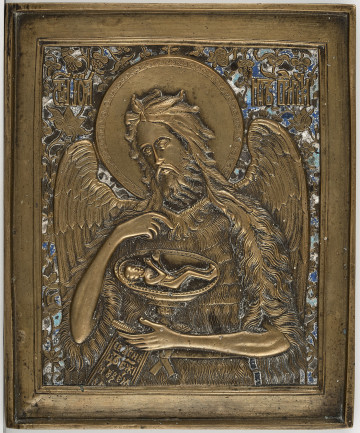
St. John the Baptist
20th century
Castle Museum in Łańcut
Part of the collection: Icons
Crucifixion. Cast crosses were widely used in Rus. The main materials for their production were copper and silver. They were modelled on Byzantine products which were few in relation to the demand, which is why mass production of objects of Christian worship already developed in Rus in 11th-12th c. The most important factories were located in Kiev, Veliky Novgorod, Moscow, and over time, throughout the whole of Russia. In Byzantium, the cross was most commonly four-pointed with one crossbeam. This form was known and used in Russia, where the veneration of the cross was widespread. It accompanied every Christian throughout their life, from birth to death. Relatively small crosses with a loop were worn around the neck. Under the clothes, small decorative crosses were worn on the body, hence called 'niatielniki'. Ones displayed on the chest and visible on the clothes were called 'napiersny'. Under the influence of the Baroque, since the end of the 17th and 18th c., elaborate forms of crosses with decorative ends of the beams appeared, like the one displayed here. On the ends of the crossbeam, those accompanying the Crucifixion are portrayed in half-figure: the Mother of God and Martha (the Gospels list three women), as well as John the Evangelist and the centurion Longinus. Beneath the arms of the Saviour, the Jerusalem temples were marked schematically. The vertical beam was usually decorated with depictions of two trinities: the depiction of the Old Testament Holy Trinity at the top (fragment not preserved) and the opposing trinity of torturers dividing Christ's clothes under the cross (Psalm 22:19; Matthew 27:35; Mark 15:24; Luke 23:34; John 19:23-24). On the displayed cross, instead of the wicked trinity, there are the saints Nicetas subduing the devil and bishop Nicholas the Wonderworker. Two other intercessors were placed at the base of the cross. Most often, they were the early Christians Menas of Egypt and Tikchon of Cyprus, or Sergius of Radonezh with his disciple Nikon, who lived in the 14th-15th c. Teresa Bagińska-Żurawska https://orcid.org/0000-0002-9243-3967
Dimensions
height: 8.5 cm, width: 7.7 cm
Object type
Icons
Technique
cast
Material
bronze
Origin / acquisition method
decyzja administracyjna
Creation time / dating
Creation / finding place
Owner
Castle Museum in Łańcut
Identification number
Location / status

20th century
Castle Museum in Łańcut

19th (?) century
Castle Museum in Łańcut

1800 — 1850
Castle Museum in Łańcut
DISCOVER this TOPIC
Castle Museum in Łańcut
DISCOVER this PATH
Educational path